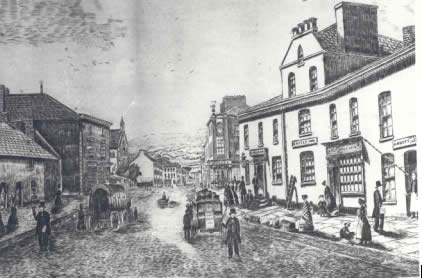From 19thC Merthyr Tydfil to the internet – the fight for public spaces
I recently greatly enjoyed reading an essay by my stepdaughter, Arddun Arwyn. Not quite sure what the title was but the essay was about ” the late Victorian civic project” to civilise the streets of Methyr Tydfil, then a fast growing iron town in industrialising South Wales and seen by contempory middle class observers as a den of lawlessness and immorality.
Arddun cites Croll who bases his analysis of the civic project in Merthyr on Michel Foucault’s theory that power is “dispersed through a range of complex social networks” and is not held by one dominant group in society.
Reading the essay, I got drawn into thinking about the parallels between attitudes towards the social networks of the streets of Merthyr and open social networks. In both cases attempts to control the open spaces are based on providing walled gardens and on promoting new ideas of private property. Anyway here are a couple of extracts from the essay – hope you enjoy them as much as I did.
“In the late Victorian era it is evident that there was a distinctive shift the meanings of ‘public’ and ‘private’ space and the activities deemed to be acceptable in these spaces. If we refer to court records from Merthyr in the latter part of the century we can see evidence that demonstrates this. A boy came before the courts for playing bat and ball in a Merthyr street, his mother in his defence explained that she herself had played in that street as a child and that there was no other places for children to play. Despite this the boy was fined two shillings for his misdemeanour. Similarly emigrants from rural areas of Wales were learned in the new codes of ‘private’ and ‘public’, which became so important in this era. A William Evans was caught playing quoits in a field belonging to the Dowlais Iron Company and was fined 5 shillings for causing ‘wilful damage’ to the company’s land. Evans explained to the court “‘he came from Cardiganshire, where they were allowed to play were they liked, and having only been in Dowlais for a week, he did not know he was doing any harm.’” Another case which underlines this point is that of two men who were discovered drunk and about to engage in a prize-fight, they walked free as the encounter took place on a privately owned field rather than in a ‘public’ space.
This shift in how the use of ‘public’ space was perceived had a profound effect on the most ‘public’ of spaces, the street.
Andy Croll argues that although the streets were the most ‘public’ and therefore ‘freest’ area of towns “the freedom that defined public space was heavily regulated, through codes and which distinguish between ‘civilised’ and ‘uncivilised’ behaviour”3 It became the battle of the ‘public’ to reclaim and regulate what they deemed to be ‘public’ space.4 Codes of street etiquette were in place to ensure that Victorian streets were an area of movement, silence and safety. This would prove problematic if we consider the function of the street to some members of the ‘public’. Martin Daunton’s work into working class areas has concluded that, when working class areas were re-built from courts and allies to open streets the usage of the street by these members of the public reflected their “boisterous and vibrant culture’ which had before been enacted in a ‘private’ area of the enclosed court. Andrew Davies, similarly argues that the street was an integral part of working class sociability.”
“The presence of a vibrant street culture as described by Martin Daunton, was a direct challenge to aspirations of movement, silence and safety ascribed to Victorian thoroughfares by those wishing to ‘civilise’ the streets. Another means of regulating behaviour and ensuring the aforementioned values were sustained was the trend by municipal governments and prominent members of society to provide areas were ‘rational’ recreation could be practised. If we consider Swansea as an example they is much evidence that demonstrates this shift in policy. In the years prior to 1870 municipal governments were reluctant to support schemes that would cost the ratepayers to initiate, however after 1870 the business community experienced a period of prosperity, which obligated municipal governments to provide a wider range of social services for inhabitants. The initiatives undertaken were usually in the form of parks and public libraries. “The Open Spaces Movement” endeavoured, under the leadership of William Thomas, to provide parks and playgrounds in areas of the town were there were “no facilities other than the streets and gutters in which to play.” Similarly the establishment of libraries and other such cultural centres i.e. art galleries, museums, was regarded as an important means of providing ‘rational’ recreation for the working man. The Public Libraries Act of 1866 and the work of campaigners paved the way for the establishment of Swansea’s public library and reading rooms in 1869. We see similar initiatives being completed in Merthyr under the patronage of the Ironmasters.”

